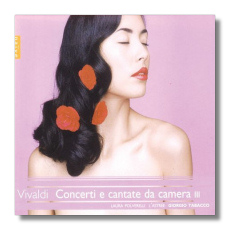
The Internet's Premier Classical Music Source
Related Links
- Vivaldi Reviews
- Latest Reviews
- More Reviews
-
By Composer
-
Collections
DVD & Blu-ray
Books
Concert Reviews
Articles/Interviews
Software
Audio
Search Amazon
Recommended Links
Site News
 CD Review
CD Review
Antonio Vivaldi

Chamber Concertos & Cantatas
- Concerto in C Major, RV 87
- Concerto in F Major "La tempesta di mare", RV 98
- Concerto in G minor, RV 103
- Cantata "Amor, hai vinto," RV 683
- Cantata "Lungi dal vago volto," RV 680
- Cantata "Vengo a voi, luci adorate," RV 682
Laura Polverelli, mezzo-soprano
L'Astrée/Giorgio Tabacco
Naïve OP30381 DDD 60:25
This is another enjoyable volume in Naïve/Opus 111's ongoing series of music by Vivaldi – specifically, manuscripts located in the National University Library in Turin. I like the idea of alternating vocal cantatas with instrumental concertos; the variety ensures that the music always sounds fresh. It is not known for whom these six works were written, and when. (And why.) Two of the three chamber concertos (RV 87 and 103) give a prominent role to the recorder; the third ("La tempesta di mare," or "The storm at sea") gives prominence to the "flauto transverso," or the flute. The latter work shares a nickname – and in the outer movements, more or less the same material – with the recorder (or flute concerto) designated RV 433, which is part of the composer's set of six Op. 10 concertos.
The three vocal cantatas are secular, and typical of the genre. Amor, hai vinto is a lover's plaint. The singer first fears that love will cause her (actually him, according to the text) to be torn apart like a ship on stormy seas, but then places her faith in the beloved Clori. In Lungi dal vago volto, another shepherd mourns because he cannot see the face of the adored Elvira, a shepherdess. (Of course they are reunited by the end of the cantata.) Finally, in Vengo a voi, luci adorate, yet another lover passionately addresses the lovely but pitiless eyes of the woman he loves. The first two cantatas consist of two arias, each preceded by a recitative. The third dispenses with the first recitative, beginning immediately with the first aria.
I wanted to say that the performances, as led by Giorgio Tabacco from the harpsichord, are really "smoking," but it would be more accurate to call them relaxed, but not lazy. L'Astrée finds a reasonable tempo for each movement and sticks with it throughout, without "expressive" adjustments. In both the concertos and cantatas, the continuo consists of harpsichord, cello, and theorbo. This means that there are five to seven musicians in each work. The exception is RV 103, which is scored for recorder, oboe, and bassoon, dispensing with the continuo altogether. (The effect is delightful.) Authentic instruments and performance practices are used, of course. Polverelli sings her music neatly and with plainspokenness. The microphones are close enough to the musicians to pick up their breathing, but I did not find this too distracting.
This is a nice addition to a worthwhile series.
Copyright © 2005, Raymond Tuttle




















